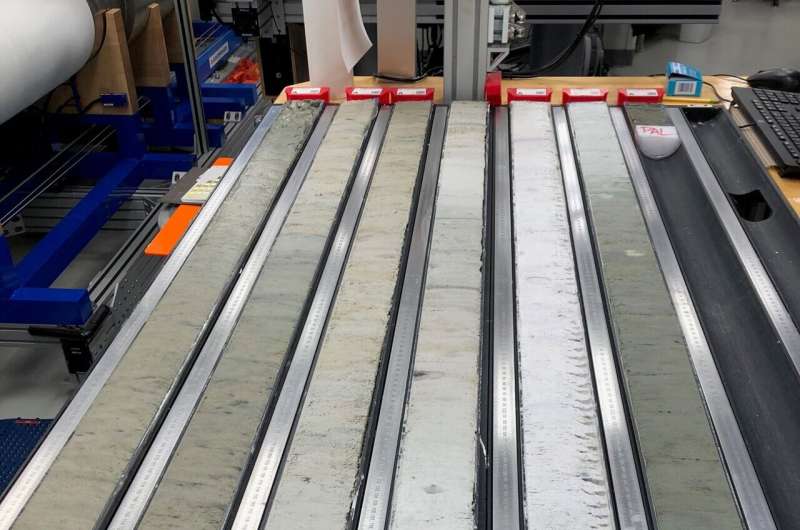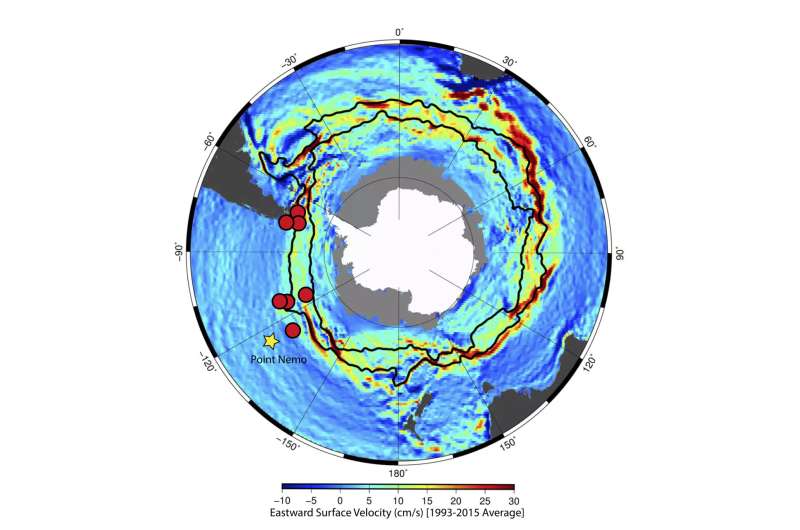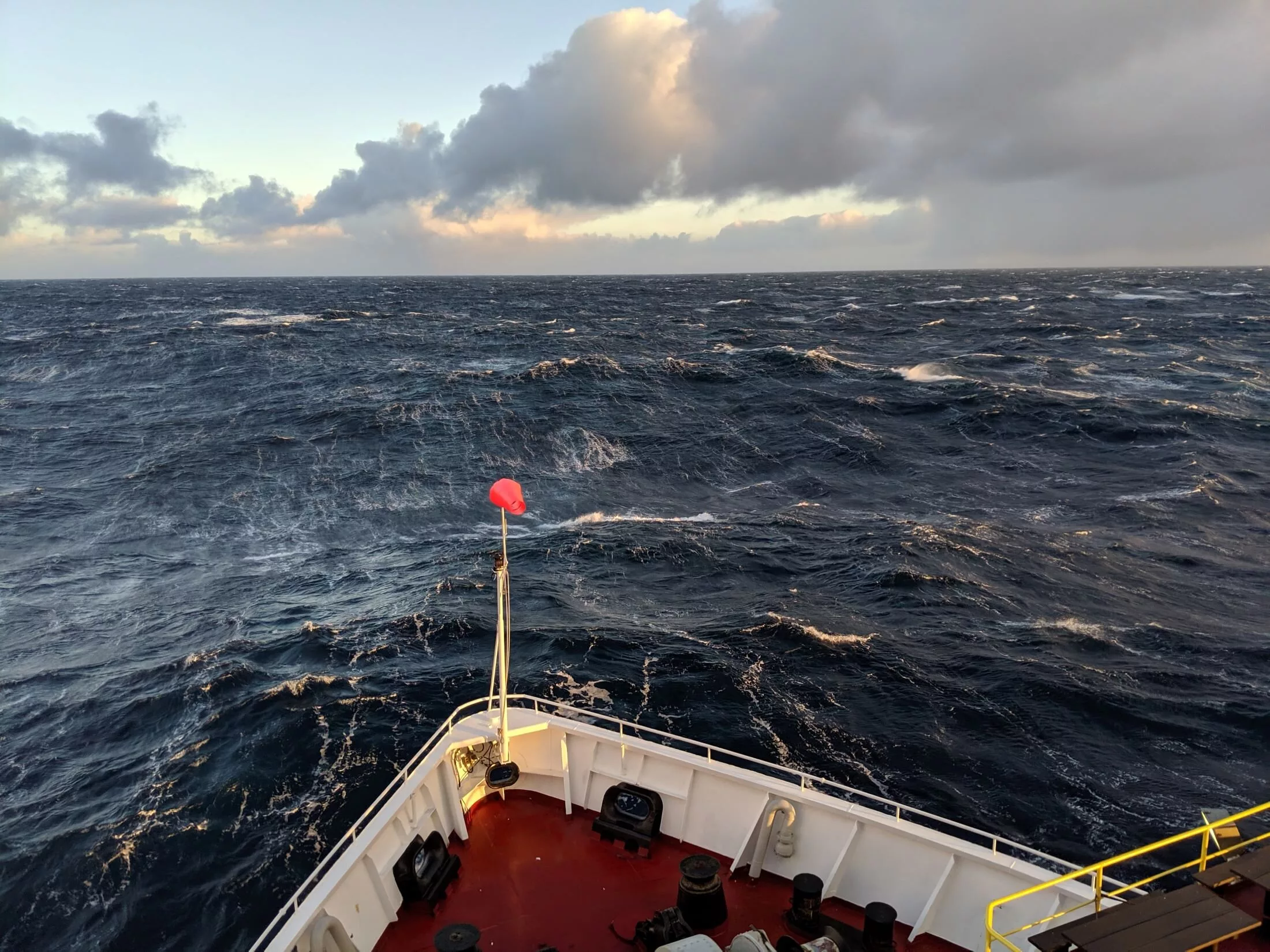It carries more than 100 times as much water as all the world’s rivers combined. It reaches from the ocean’s surface to its bottom, and measures as much as 2,000 kilometers across. It connects the Indian, Atlantic and Pacific oceans, and plays a key role in regulating global climate. Continuously swirling around the southernmost continent, the Antarctic Circumpolar Current is by far the world’s most powerful and consequential mover of water.
In recent decades it has been speeding up, but scientists have been unsure whether that is connected to human-induced global warming, and whether the current might offset or amplify some of warming’s effects.
In a new study, an international research team used sediment cores from the planet’s roughest and most remote waters to chart the ACC’s relationship to climate over the last 5.3 million years.
Their key discovery: During past natural climate swings, the current has moved in tandem with Earth’s temperature, slowing down during cold times and gaining speed in warm ones―speedups that abetted major losses of Antarctica’s ice. This suggests that today’s speedup will continue as human-induced warming proceeds. That could hasten the wasting of Antarctica’s ice, increase sea levels, and possibly affect the ocean’s ability to absorb carbon from the atmosphere.
The findings were published in the journal Nature.
“This is the mightiest and fastest current on the planet. It is arguably the most important current of the Earth climate system,” said study co-author Gisela Winckler, a geochemist at Columbia University’s Lamont-Doherty Earth Observatory who co-led the sediment sampling expedition. The study “implies that the retreat or collapse of Antarctic ice is mechanistically linked to enhanced ACC flow, a scenario we are observing today under global warming,” she said.

The conditions for the ACC were set about 34 million years ago, after tectonic forces separated Antarctica from other continental masses further north and the ice sheets began building up; the current is thought to have started flowing in its modern form 12 million to 14 million years ago.
Driven by continuous westerly winds, and with no land in the way, it circles Antarctica clockwise (as seen from the bottom of the Earth) at about 4 kilometers (2.5 miles) per hour, carrying 165 million to 182 million cubic meters of water each second.
Scientists have observed that winds over the Southern Ocean have increased in strength about 40% in past 40 years. Among other things, this has speeded the ACC and energized large-scale eddies within it that move relatively warm waters from the higher latitudes toward Antarctica’s huge floating ice shelves, which hold back the even vaster interior glaciers.
In parts of Antarctica, especially in the west, these warm waters are eating the undersides of the ice shelves―the main reason they are wasting, not warming air temperatures.
“If you leave an ice cube out in the air, it takes quite a while to melt,” said Winckler. “If you put it in contact with warm water, it goes rapidly.”
“This loss of ice can be attributed to increased heat transport to the south,” said the study’s lead author, Frank Lamy, of Germany’s Alfred Wegener Institute. “A stronger ACC means more warm, deep water reaches the ice-shelf edge of Antarctica.”

Through a complex set of processes, the ocean waters ringing Antarctica also currently absorb about 40% of the carbon that humans introduce into the atmosphere. It is unclear whether the speedup of the ACC will compromise this, but some scientists fear it will.
The study involved some 40 scientists from a dozen countries. At sea, aboard the drill ship JOIDES Resolution, researchers gathered ocean-floor sediment underlying the ACC near Point Nemo—the spot in the far southwestern Pacific that is farthest from land anywhere, some 2,600 kilometers from even the tiny Pitcairn Islands. The two-month cruise took place from May to July 2019, during the violent austral winter, when there was little daylight and waves as high as 20 meters threatened the ship.
The ship’s crew dropped a drill string some 3,600 meters from the ocean surface to the ocean floor. They then penetrated the floor and removed thin sediment cores measuring 150 and 200 meters each.
Using an advanced X-ray technique, the scientists later analyzed layers built up over millions of years. Since smaller particles tend to settle during times when the current is sluggish and larger ones when it is fast, they were able to chart scores of changes in the ACC’s speed over time.
Compared to the mean flow over the last 12,000 years―the period since the last ice age encompassing the development of human civilization―flows dropped by as much half during cold times, and at times nearly doubled during warm ones.
Using previous studies of the West Antarctic Ice Sheet, they correlated fast-flow periods with repeated bouts of ice retreat. These were punctuated by colder times, when glaciers advanced. The warmest extended period of the 5.3-million year record was during the Pliocene, which ended about 2.4 million years ago.
After that came a period called the Pleistocene, when dozens of chilly glacial periods alternated with so-called interglacials, when temperatures rose, the current speeded up and the ice pulled back. Currently much of the West Antarctic Ice Sheet is frozen to land that is below sea level, so it is highly susceptible to invasion by warm ocean waters. Were it to melt entirely, it would raise global sea levels by about 190 feet.
“These findings provide geological evidence in support of further increasing ACC flow with continued global warming,” the researchers write in their paper. “If true, a future increase in ACC flow with warming climate would mark a continuation of the pattern observed in instrumental records, with likely negative consequences.”
More information:
Frank Lamy, Five million years of Antarctic Circumpolar Current strength variability, Nature (2024). DOI: 10.1038/s41586-024-07143-3. www.nature.com/articles/s41586-024-07143-3
Provided by
Columbia Climate School
Citation:
Newly uncovered history of a key ocean current carries a warning on climate (2024, March 27)
retrieved 28 March 2024
from
This document is subject to copyright. Apart from any fair dealing for the purpose of private study or research, no
part may be reproduced without the written permission. The content is provided for information purposes only.
Reference :
Reference link























+ There are no comments
Add yours